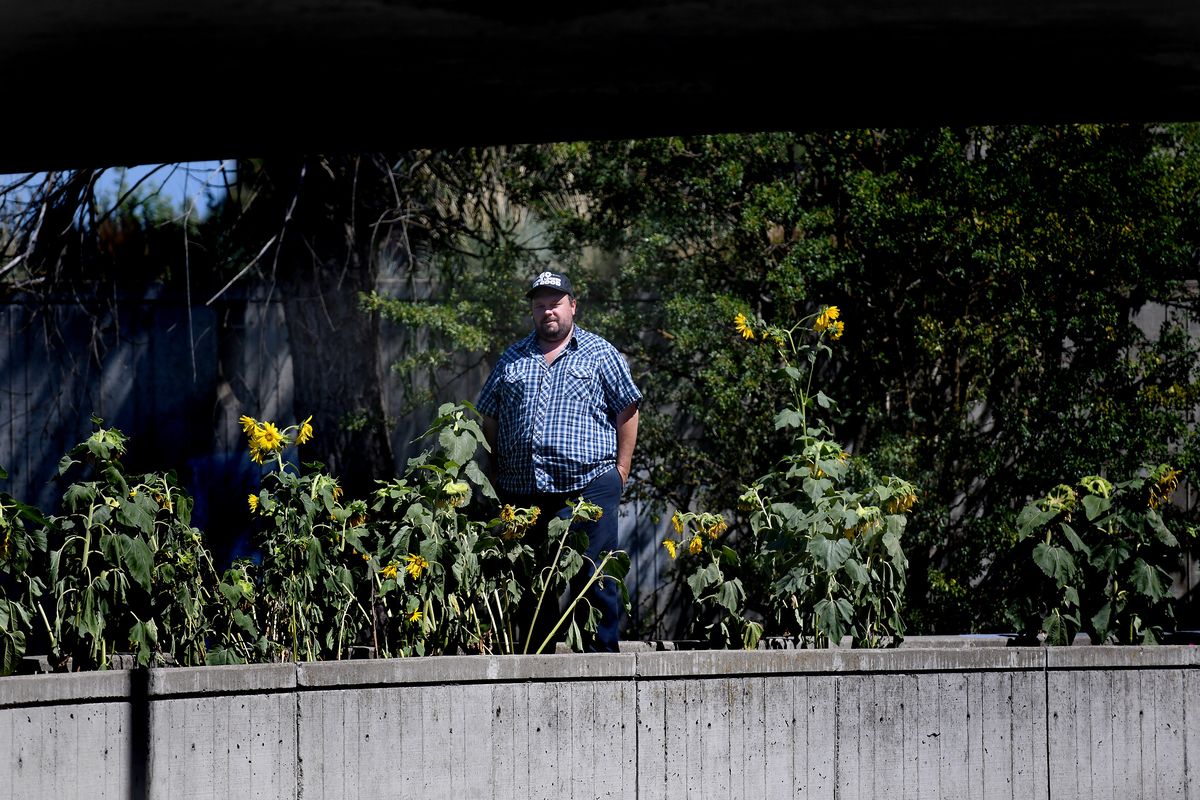‘Guerrilla’ gardener brings wild tactics to Riverfront Park, and Spokane reaps the flowery results

After Hurricane Katrina devastated New Orleans in 2004, Pete Syverson noticed one little bright spot in the wreckage. Sunflowers.
The high winds and churning floodwaters uprooted gardens around the city. Seeds got swept away in the current and made new homes where they could, springing up among the wreckage as the city rebuilt.
Things often are a lot easier to grow in Louisiana’s hot, humid climate, Syverson said. But when he moved to Spokane from New Orleans a little over a year ago, he felt his new home could use a bright spot too – hurricane or no hurricane.
Earlier this year, Syverson was walking his black Lab mix Steve around Riverfront Park when he noticed planters sitting empty – just boxes of dirt and missed potential, he said. So he reached out to Spokane’s parks department, asking if he could take over their upkeep himself.
“I know the city has limited resources and maybe planters aren’t at the top of their list of priorities, I get that,” Syverson said. “But I just thought, ‘Wouldn’t it be nice if we all took part in making something nice?’”
But this was March, just before the coronavirus pandemic swept into the Inland Northwest. The parks department, likely with other things on its mind, never did get back to Syverson. He started planting anyways.
Syverson is what some might call a “guerrilla gardener,” planting wild things in public spaces without care or fear of who truly owns the property. Guerrilla gardening got its name from a Belgian movement of planting flowers around cities in the early 2000s, and a blog at www.guerrillagardening.org/ now documents the movement’s “war against neglect and scarcity of public space” across countries and continents.
The concept isn’t necessarily new to Spokane – Syverson noted there are wild berries all around the city, and even a thicket of hops someone planted years ago under the Division Street bridge.
All that tongue-in-cheek freedom fighter talk is a great way to rally people around the worthy cause of beautifying public spaces, Syverson said, but he’s not necessarily trying to “bring The Man down.” If the city really took issue with his sunflowers, he says he’d cut them down. They’re annuals, anyway – by the fall, they’ll die and turn into mulch for the surrounding soil.
“I’m just a nice neighborhood gardener, really,” Syverson said. “Everyone likes flowers.”
Syverson walked down to Riverfront Park one day this spring and simply scattered a handful of sunflower seeds onto the soil in the planters. The rest was “set it and forget it,” Syverson said.
Ducks and geese helped push the seeds into the soil over time, and in the process of eating a good chunk of the seeds, provided the survivors with fertilizer, Syverson said. When seedlings started to emerge, he and Steve brought them water on their daily walks. Before long, the flowers erupted into tall, beautiful stalks, transforming the once-dreary empty planters into something the whole city could enjoy.
Sunflowers seemed the obvious choice because they do well in nearly any climate, and their deep roots help till the earth and promote soil health, Syverson said. Plus, they’re just pretty.
Since the flowers sprung up in the park, Syverson said he’s noticed fewer cigarette butts get flicked into the surrounding plants. More people hang around the area to watch the sunset or take a quick break on their run. One of Syverson’s friends even reported seeing a couple on a stroll pause to water the flowers with their water bottles.
For a total out-of-pocket investment of $2.50, Syverson says he’s quite pleased with the results.
It’s too late in the season now to start planting any more flowers, Syverson said. But going into the future, he said he could see himself expanding his guerrilla tactics to roadside medians and drab roundabouts in neighborhoods throughout the city, perhaps even linking forces with like-minded amateur gardeners or botany groups, like Spokane Friends of Monarchs, a Spokane conservation group that grows and distributes pollinator-friendly milkweed for planting in backyards.
Everywhere he looks now, Syverson sees empty spaces that could be filled with lovely flowers and native plants. If everyone got on board with Syverson’s guerrilla tactics, he envisions a greener, more cheerful Spokane, with cleaner air and accessible flowers for all who seek that perfect photo op.
“You don’t have to have a green thumb to do it,” Syverson said. “Just throw some seed and see what happens. We could all benefit from a little beauty right now, right?”